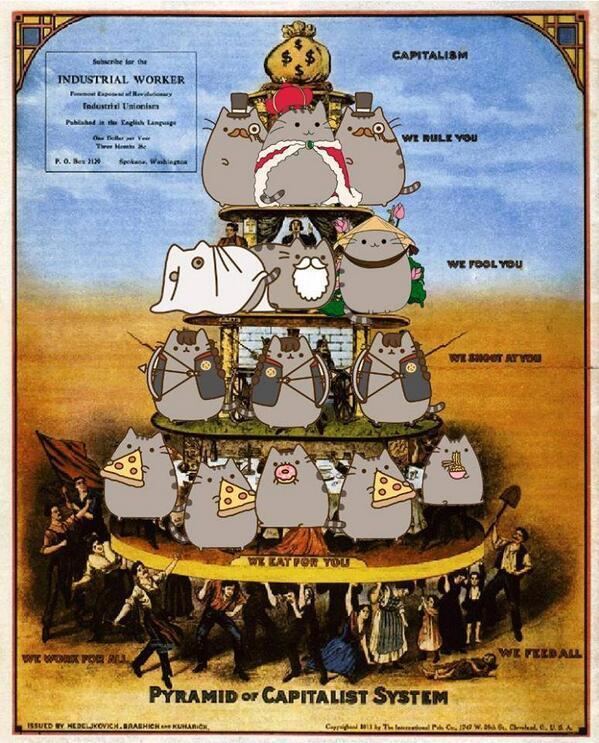Capitalism is an economic system that shapes the world we live in today, and its structure can be likened to a pyramid. At the top of this pyramid lies the wealthiest individuals and corporations, while the broader base consists of the working class. This system has been both praised for fostering innovation and criticized for perpetuating inequality. Understanding the pyramid of the capitalist system is crucial for comprehending how wealth is distributed and how economies function globally.
The concept of the capitalist system's pyramid has intrigued economists, sociologists, and policymakers alike. It highlights the disparities in wealth distribution and the mechanisms that sustain these inequalities. By analyzing this structure, we can better understand the challenges faced by societies and explore potential solutions to create a more equitable economic framework.
As we delve deeper into the layers of the capitalist pyramid, it becomes evident that this system is not merely about wealth accumulation but also about power dynamics and social hierarchies. This article aims to provide a comprehensive overview of the pyramid of the capitalist system, exploring its components, implications, and potential reforms. Whether you are an economist, a student, or simply someone interested in understanding the global economy, this article offers valuable insights into the workings of capitalism.
Read also:Exploring The Allure Of Sydney Sweeney Nude A Deep Dive Into The Stars Journey
Table of Contents
- Introduction to the Pyramid of Capitalist System
- The Structure of the Capitalist Pyramid
- Wealth Distribution in the Capitalist System
- Power Dynamics Within the Pyramid
- Impact of the Pyramid on Economic Growth
- Addressing Inequality in the Capitalist Pyramid
- A Historical Perspective on the Pyramid
- Globalization and the Pyramid of Capitalism
- Potential Reforms to the Capitalist System
- Conclusion and Future Directions
Introduction to the Pyramid of Capitalist System
The capitalist system's pyramid serves as a metaphor for the stratification of wealth and power within societies. At its core, it represents the hierarchy of economic classes, where the wealthiest individuals and corporations occupy the uppermost tier, while the majority of the population forms the base. This structure has been a subject of debate among scholars, with some arguing that it drives innovation and economic progress, while others criticize it for exacerbating social inequalities.
Understanding the pyramid of the capitalist system requires examining its historical development and the factors that contribute to its perpetuation. From the industrial revolution to the digital age, the dynamics of wealth distribution have evolved, yet the fundamental structure remains intact. This section explores the foundational principles of the capitalist pyramid and its relevance in contemporary society.
The Structure of the Capitalist Pyramid
Key Components of the Pyramid
The capitalist pyramid comprises several key components, each playing a distinct role in the overall structure. These components include:
- Elite Class: The top tier consists of wealthy individuals, corporations, and financial institutions that control significant resources and decision-making power.
- Middle Class: Positioned in the middle, the middle class includes professionals, small business owners, and skilled workers who contribute to economic stability.
- Working Class: The base of the pyramid is formed by the working class, who provide labor and are essential for the functioning of the economy.
Each of these components interacts with the others, creating a complex network of relationships that sustain the capitalist system.
Interactions Between Classes
The interactions between different classes within the pyramid are crucial for understanding how wealth and power are distributed. The elite class often influences political and economic policies, while the middle and working classes contribute to economic productivity. This section delves into the mechanisms that facilitate these interactions and their implications for societal development.
Wealth Distribution in the Capitalist System
Wealth distribution is a central aspect of the capitalist pyramid, highlighting the disparities between different economic classes. According to a report by Oxfam, the wealthiest 1% of the global population owns more than half of the world's wealth, underscoring the concentration of resources at the top of the pyramid. This section examines the factors contributing to wealth inequality and the consequences for societies.
Read also:Renowned Medical Expert Dr Gustavo Quiros A Journey Of Excellence
Data from the World Inequality Database further reveals that income inequality has been on the rise in many countries, with the top 10% of earners capturing a disproportionate share of economic growth. These statistics underscore the need for policies aimed at addressing wealth disparities and promoting equitable distribution.
Power Dynamics Within the Pyramid
Control of Resources
The control of resources is a critical element of power dynamics within the capitalist pyramid. The elite class often wields significant influence over natural resources, financial markets, and technological advancements. This control enables them to shape economic policies and maintain their position at the top of the pyramid.
Influence on Political Systems
Political systems are not immune to the influence of the capitalist pyramid. Lobbying and campaign financing allow the elite class to exert pressure on policymakers, often prioritizing corporate interests over public welfare. This section explores the intersection of economics and politics within the capitalist system and its implications for democratic governance.
Impact of the Pyramid on Economic Growth
The capitalist pyramid plays a pivotal role in driving economic growth through innovation and investment. The concentration of wealth at the top facilitates capital accumulation, which can be reinvested into new ventures and technologies. However, this growth is not always inclusive, as the benefits often fail to trickle down to lower economic classes.
Studies by the International Monetary Fund (IMF) suggest that reducing inequality can lead to more sustainable economic growth. This section discusses the relationship between the capitalist pyramid and economic development, emphasizing the importance of equitable policies.
Addressing Inequality in the Capitalist Pyramid
Policies for Reducing Inequality
To address inequality within the capitalist pyramid, policymakers must implement strategies that promote equitable wealth distribution. These policies may include progressive taxation, social welfare programs, and investments in education and healthcare. By redistributing resources, societies can reduce the disparities that characterize the capitalist system.
Role of Education and Skill Development
Education and skill development are essential tools for empowering individuals and reducing inequality. By providing access to quality education, societies can enhance the capabilities of the working class, enabling them to climb the economic ladder. This section highlights the importance of education in dismantling the barriers posed by the capitalist pyramid.
A Historical Perspective on the Pyramid
The capitalist pyramid has evolved over centuries, shaped by historical events and technological advancements. From the feudal systems of medieval Europe to the industrial revolutions of the 18th and 19th centuries, the structure of economic hierarchies has continuously adapted to changing circumstances. This section provides a historical overview of the capitalist pyramid and its transformation over time.
Globalization and the Pyramid of Capitalism
Impact of Globalization on Economic Hierarchies
Globalization has reshaped the capitalist pyramid by facilitating the movement of capital, goods, and services across borders. While this has created opportunities for economic growth, it has also exacerbated inequalities between developed and developing nations. This section examines the role of globalization in reinforcing the structures of the capitalist pyramid.
Challenges and Opportunities
The challenges posed by globalization include the exploitation of labor in developing countries and the erosion of local industries. However, it also presents opportunities for collaboration and innovation on a global scale. This section discusses the dual nature of globalization and its implications for the capitalist system.
Potential Reforms to the Capitalist System
Redistribution of Wealth
Reforms aimed at redistributing wealth are crucial for creating a more equitable capitalist system. This may involve implementing policies such as universal basic income, wealth taxes, and increased social spending. By addressing the root causes of inequality, societies can work towards dismantling the existing hierarchies of the capitalist pyramid.
Encouraging Corporate Responsibility
Corporate responsibility is another avenue for reforming the capitalist system. Encouraging businesses to adopt sustainable practices and prioritize social welfare can help mitigate the negative effects of the pyramid structure. This section explores the potential of corporate responsibility in promoting a more inclusive economic framework.
Conclusion and Future Directions
In conclusion, the pyramid of the capitalist system represents the intricate hierarchies that shape our global economy. While it drives innovation and economic growth, it also perpetuates inequalities that hinder social progress. Addressing these challenges requires a multifaceted approach, combining policy reforms, education, and corporate responsibility.
We invite readers to engage in discussions about the future of capitalism and its role in shaping societies. Your insights and feedback are invaluable in fostering a deeper understanding of this complex system. Please leave your comments or share this article to continue the conversation and explore potential solutions to the challenges posed by the capitalist pyramid.


